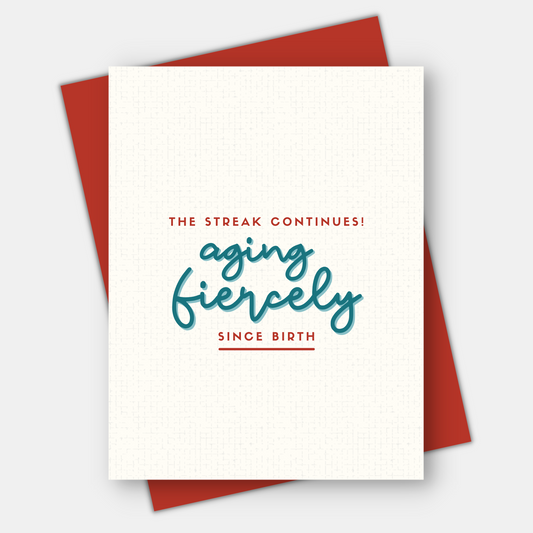
Birthday cards are one of the places ageism has taken grip in our society, making them the best place to loosen the grip.
Every year, Americans buy over 6.5 billion greeting cards, and over 50% are birthday cards!
Unfortunately, birthday cards have traditionally been the perfect way to take cheap shots at our friends and family about getting older. Scan any greeting card aisle, and you’ll still see images and sentiments focused on decline, depression, and dementia.
A National Poll on Healthy Aging study shows that 8 out of 10 people over 50 are exposed to ageist messages daily, and the greeting card aisle contributes to this problem.
Some people I know complain about the cost of a greeting card, which is currently averaging over $6, but it’s well spent for me.
Think about these opportunities.
- The exchange of a card from one person to another is a highly personal and powerful form of communication that typically happens once a year, on a birthday.
- We naturally think about age on our birthdays. It is a great time to reinforce the positive aspects of getting older, especially with people who use self-deprecating humor about age or blame age.
- The best news? Anyone who changes their mindset about aging can reap the longevity and other significant health benefits Dr. Becca Levy outlines in Breaking the Age Code.
Here are five reasons birthday cards are a great way to combat ageism:
1 - Sending a card shows people you care
- Selecting the perfect card and including a handwritten message inside is the best way to show your loved ones you care about them.
- Social media and text greetings have become popular shortcuts for birthday greetings, but research shows that 8 out of 10 people agree they do not replace the effectiveness of a greeting card.
- The more ‘card-worthy’ people in your life, the better! Research from the Blue Zones further proves that solid social ties keep you alive longer.
2 - Greeting cards have messages that people read
- Unlike other media you scan and often ignore, you read the sentiment when shopping for a greeting card to see if it fits.
- Resist the urge to purchase a card that 'pokes fun' at age, leaving a negative stereotype about aging. Don’t forget that your future boss, health care professional, and marketing directors also see these ageist messages.
- When you purchase cards with uplifting sentiments, especially about age, you impact the analytics of large makers, which determines the types of cards they put on the shelf.
3 - The power to influence family and friends
- Everyone carries internalized ageism or unconscious age bias inside of them. Use a birthday card to make your loved ones see the positive aspects of aging.
- You clarify your stance about the power of age-positivity, and the recipient gets much-needed encouragement on their birthday, a time when we naturally think about getting older.
- Since the card is often read aloud or passed around at birthday celebrations, everyone benefits from the age-positive message.
4 - Women are the target and the solution
- Women face gendered ageism, which is the intersection of ageism and sexism, resulting in pressure to maintain a youthful appearance and feelings of being less competent or valuable in the workplace.
- Many birthday cards depict women with unflattering visuals—sagging body parts, grey hair and wrinkles, and sarcastic attitudes. Nothing is off limits when making us feel worse about aging.
- Women also purchase over 80% of greeting cards, providing the perfect opportunity to use their voice and buying power to make a difference in the greeting card industry.
5 - Shop small when buying cards; it does matter
- Grocery stores, pharmacies, and big box retailers typically carry cards from large publishers, who use analytics to determine best sellers and create new sentiments.
- Small publishers can quickly adapt to social trends and meet niche market needs, including providing age-positive messaging.
- Shop at stationery stores, gift stores, and boutiques, and when you find an age-positive card, go to the makers’ website to stock up online.
It can feel daunting to fight ageism. In our youth-obsessed culture, the roots run deep.
As you can see, greeting cards are an effective way to loosen the grip of ageism, especially with family and friends.
You may need to change how you shop for greeting cards to find the good ones. Shopping small increases your chances of finding niche designs from individual sellers.
Stock up when you find an outstanding, age-positive card like those from Age-Friendly Vibes! It’s a great way to fight ageism and use your buying power to impact change.




